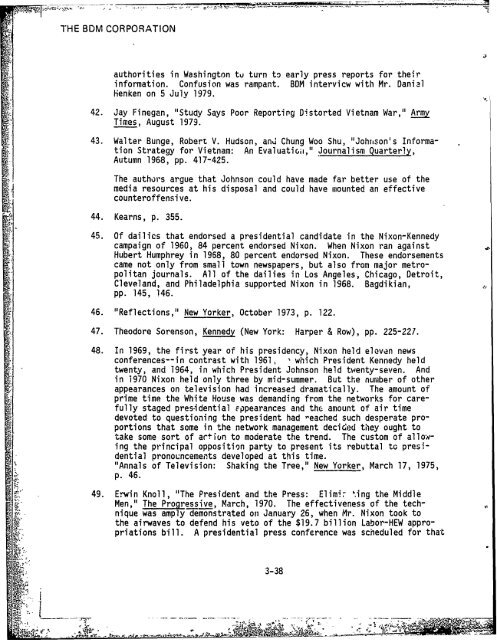policy - The Black Vault
policy - The Black Vault
policy - The Black Vault
Create successful ePaper yourself
Turn your PDF publications into a flip-book with our unique Google optimized e-Paper software.
THE BDM CORPORATION<br />
authorities in Washington to turn to early press reports for their<br />
information. Confusion was rampant. BDM intervicw with Mr. Danial<br />
Henken on 5 July 1979.<br />
42. Jay Finegan, "Study Says Poor Reporting Distorted Vietnam War," Army<br />
Times, August 1979.<br />
43. Walter Bunge, Robert V. Hudson, and Chung Woo Shu, "Johnson's Information<br />
Strategy for Vietnam: An Evaluatioio," Journalism Quarterly,<br />
Autumn 1968, pp. 417-425.<br />
<strong>The</strong> authors argue that Johnson could have made far better use of the<br />
media resources at his disposal and could have mounted an effective<br />
counteroffensive.<br />
44. Kearns, p. 355.<br />
45. Of dailics that endorsed a presidential candidate in the Nixon-Kennedy<br />
campaign of 1960, 84 percent endorsed Nixon. When Nixon ran against<br />
Hubert Humphrey in 1968, 80 percent endorsed Nixon. <strong>The</strong>se endorsements<br />
came not only from small town newspapers, but also from major metropolitan<br />
journals. All of the dailies in Los Angeles, Chicago, Detroit,<br />
Cleveland, and Philadelphia supported Nixon in 1968. Bagdikian,<br />
pp. 145, 146.<br />
46. "Reflections," New Yorker, October 1973, p. 122.<br />
47. <strong>The</strong>odore Sorenson, Kennedy (New York: Harper & Row), pp. 225-227.<br />
48. In 1969, the first year of his presidency, Nixon held eleven news<br />
conferences--in contrast with 1961, , which President Kennedy held<br />
twenty, and 1964, in which President Johnson held twenty-seven. And<br />
in 1970 Nixon held only three by mid-summer. But the number of other<br />
appearances on television had increased dramatically. <strong>The</strong> amount of<br />
prime time the White House was demanding from the networks for carefully<br />
staged pres-idential eppearances and thG amount of air time<br />
devoted to questioning the president had reached such desperate proportions<br />
that some in the network management decided they ought to<br />
take some sort of artiun to moderate the trend. <strong>The</strong> custom of allowing<br />
the principal opposition party to present its rebuttal to presidential<br />
pronouncements developed at this time.<br />
"Annals of Television: Shaking the Tree," New Yorker, March 17, 1975,<br />
p. 46.<br />
S49. Erwin Knoll, "<strong>The</strong> President and the Press: Elimi• ring the Middle<br />
Men," <strong>The</strong> Progressive, March, 1970. <strong>The</strong> effectiveness of the technique<br />
was amply demonstrated on January 26, when Mr. Nixon took to<br />
the airwaves to defend his veto of the $19.7 billion Labor-HEW appropriations<br />
bill. A presidential press conference was scheduled for that<br />
3-38<br />
--- tot, -
















